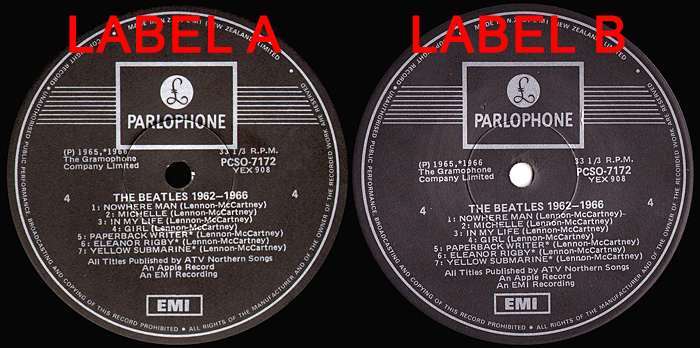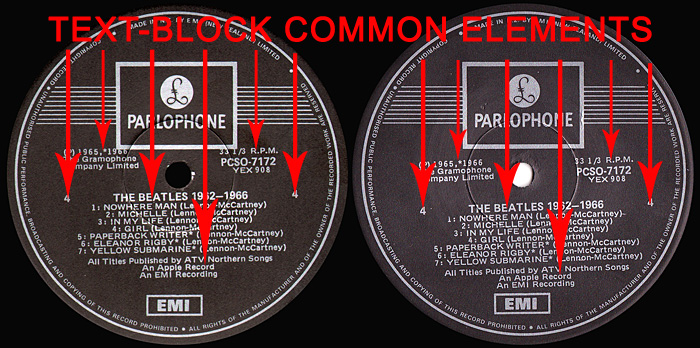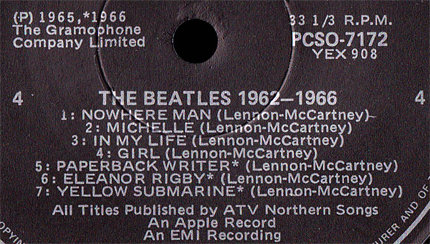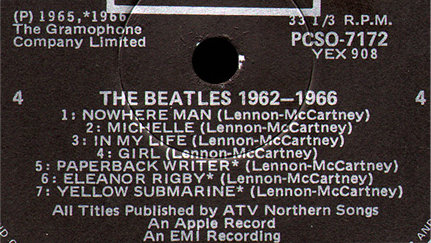Variations explained
'Variation', in the context of this labelography, is defined as a change to one or more of the text elements in labels, within a generic label style (a base design such as 'Banner' STEREO' or 'orange 1-EMI Box'), which is the consequence of conscious action by the typesetter. We know that EMI typesetters would make alterations that served to identify the typesetter for a given pressing batch.
Label composition
Labels are initially printed as a base onto which disc-specific information is later printed. The base is a template that contains only those text and image elements that are common to the generic label style, elements that remain the same regardless of the artist or the disc details (the image at right illustrates a generic base label).
The integrity of the generic base layout is so consistent that it is a reliable reference against which variations in the non-generic elements can be more easily observed (to date, only one notable variation in a generic base has come to light (see mouseover image below).
It is onto this base label, at a later stage of production, that information unique to the record being pressed is printed as a block (as arranged by typesetters). This information includes the artiste, record title, tracklist, 'side' numbers, record catalogue and matrix numbers, music publishing royalty stamps, and audio format.
In summary, and for the purposes of this labelography, a label comprises two distinct sets of elements:
1) generic 'base' elements that are not altered by the typesetter (the generic base)
2) record-specific elements that can be altered by the typesetter (the typesetter block)
Labels are initially printed as a base onto which disc-specific information is later printed. The base is a template that contains only those text and image elements that are common to the generic label style, elements that remain the same regardless of the artist or the disc details (the image at right illustrates a generic base label).
The integrity of the generic base layout is so consistent that it is a reliable reference against which variations in the non-generic elements can be more easily observed (to date, only one notable variation in a generic base has come to light (see mouseover image below).
It is onto this base label, at a later stage of production, that information unique to the record being pressed is printed as a block (as arranged by typesetters). This information includes the artiste, record title, tracklist, 'side' numbers, record catalogue and matrix numbers, music publishing royalty stamps, and audio format.
In summary, and for the purposes of this labelography, a label comprises two distinct sets of elements:
1) generic 'base' elements that are not altered by the typesetter (the generic base)
2) record-specific elements that can be altered by the typesetter (the typesetter block)

Part 1: Variation defined - a common misunderstanding
In the context of this labelography, a variation is defined as one or more changes to the elements that comprise the typesetter block. It is a common misunderstanding that the shifting of an entire unchanged typesetter block relative to the generic base is also a variation - it is not!!!
The two labels in the image at right are from two separate copies of the same album. At first glance it appears that label B is a variation of label A.
On closer examination, however, the typesetter block is identical for each, ie there are no variances observed between any of the elements which comprise the typesetter blocks of each label. See mouseover image below.
The only difference between the two labels is the positioning of the typesetter block, as a whole, relative to the generic base, resulting from block movement during the printing stage (a common occurrence).
Labels with identical typesetter blocks that are printed at a different angle or at a different position relative to the generic base do not constitute a variation insofar as this labelography is concerned.
In the context of this labelography, a variation is defined as one or more changes to the elements that comprise the typesetter block. It is a common misunderstanding that the shifting of an entire unchanged typesetter block relative to the generic base is also a variation - it is not!!!
The two labels in the image at right are from two separate copies of the same album. At first glance it appears that label B is a variation of label A.
On closer examination, however, the typesetter block is identical for each, ie there are no variances observed between any of the elements which comprise the typesetter blocks of each label. See mouseover image below.
The only difference between the two labels is the positioning of the typesetter block, as a whole, relative to the generic base, resulting from block movement during the printing stage (a common occurrence).
Labels with identical typesetter blocks that are printed at a different angle or at a different position relative to the generic base do not constitute a variation insofar as this labelography is concerned.


Part 2: Variation defined - what constitutes a variation?
Any change in the style or placement of any of the elements that comprise the typesetter block is considered to be a variation. Variations can be as prominent as a change to a font, or as obscure as a change to the kerning (the space between individual text characters) of a single text character in a single word.
Examples of variances are illustrated via the below images, which provide comparison images on mouseover.
Any change in the style or placement of any of the elements that comprise the typesetter block is considered to be a variation. Variations can be as prominent as a change to a font, or as obscure as a change to the kerning (the space between individual text characters) of a single text character in a single word.
Examples of variances are illustrated via the below images, which provide comparison images on mouseover.
Font...
Case...
Style...
Relative elements...
Kerning...
Altered credits...















